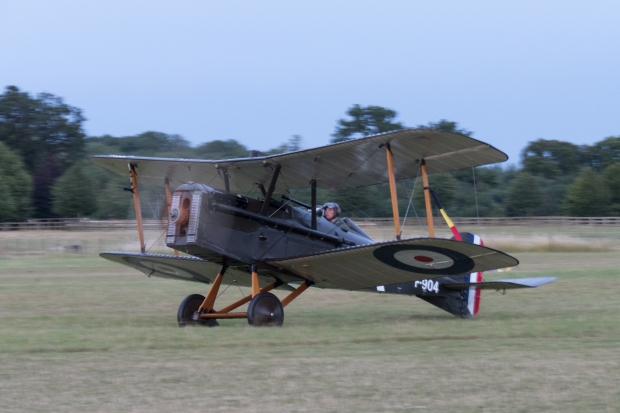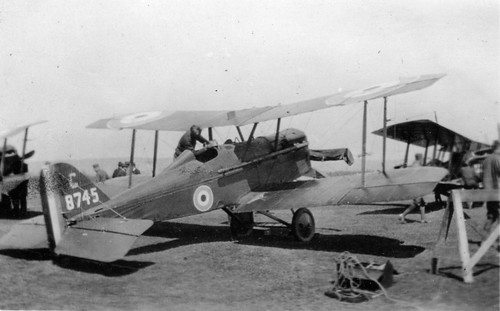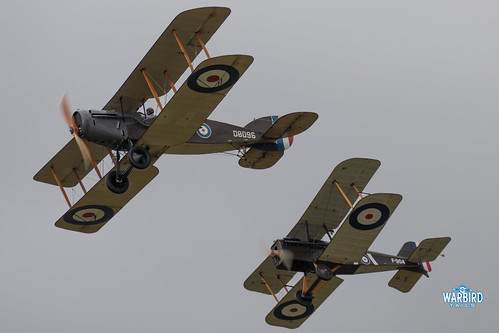Another new series of posts I am trying to put together take a look at the begining and end of key stages of fighting aircraft. These “handover” points can be seen in a number of key designs in history. The end of the great war saw favour change from the rotary unstable scout, which to my mind ended with the Sopwith Snipe or Niuport 28, to the in line stable fighter aircraft – such as the SE5a or Fokker DVII. These aircraft would go on to set a standard that would last right through until the Gladiator had its final say before the advent of monoplane fighters in the late 1930s. I’ve decided to start this series with this first noticable change in gear and the advent of the SE5a.
The Royal Aircraft Factory Scout Experimental Five, or “SE5” for short, first took to the air on the 22nd November 1916. From humble beginnings this new design would go on to become one of the most highly rated aircraft of the entire First World War.
The SE5 was designed by Henry Folland – another great example of the incredible speed of aviation development in the first half of the 20th Century, eventually going on to design the Gnat under his own company.
Early flights led to the first two prototypes being destroyed in accidents due to wing design failure. For such an iconic aircraft the early versions of the design were not rated by pilots of the time. The high seating position being a notable concern. These problems were taken into account, reuslting in a modified new version of the design being completed. The “a” model, hence the aircraft being most commonly referred to as SE5a.

In an era where the rotary engine was still leading the field the tide was slowly turning, with V engines becoming more and more common place. SE5s flew with two main power plants during service, both V8s producing 200hp. The British built engine was the Wolseley Viper, which can be seen in action powering the Shuttleworth Collection’s SE5a, and the American built Hispano-Suiza 8. Hispano was already a well known name in aero engines by the time the SE5 was developed.
The SE5 entered service in March 1917 and was quickly praised by many pilots, once the initial problems had been resolved and proved to be an incredible fighting machine. Where the Camel had greater agility, it was unstable and very difficult to fly, while the SE5 was a very stable machine and the fastest of the conflict. Modern day pilots have commented how the SE5a flies so well that it would be easy to mistake for a 1930s design. While the Camel may have been the headline act for historians looking back at the conflict it was a ferocious and downright dangerous machine for an inexperienced pilot, the SE5a on by comparison was a pleasure.

With the 200hp motor propelling the new airframe through the air to a top speed of 138mph and up to a maximum altitude of 17,000 feet, the Royal Flying Corps found themselves a powerful new weapon. The excellent flying characteristics would be useless without some firepower. The SE5a featured a Lewis gun mounted on top of the wing and a Vickers gun firing through the propeller giving the pilot plenty of options.
As one of the most successful aircraft of the war, it is unsurprising that the SE5a created a long list of aces, in fact there were over 200 by the end of the war. The legend that was Albert Ball was one of the most familiar names to take charge of the new scout while other less familiar names such as Frederick Travers (widely believed to be the only Bristol M1c ace, though RFC records show his kills were actually achieved in the SE5) also saw great success in the SE5a.
The SE5 certainly earned its place as one of the most impressive fighters of the First World War and along with the Fokker DVII marked the start of a whole new era of fighting aeroplanes, this was the start of the lineage that would run right through to the Hawker biplanes and Gloster Gladiator shortly before WW2.
How does a fighter earn its keep, once the fighting is done?
With the aeroplane still in its infancy, though vastly developed thank to the acceleration of war, the late 1910s and early 20s represented the first time that military aircraft had been made surplus on mass, what would be made of the SE5, a hugely capable aircraft, now the task at hand had finished.
I am going to pick on one particularly notable role that the SE5a performed post war that certainly kept it in the public eye. Previously an apprentice of Claude Graeme-White at Hendon a businessman by the name of John Savage decided to capitalise on the aeroplane, more specifically the ability to create smoke trails. Ahead of his time, Savage instantly saw the money making opportunities from this.
Savage decided that the aircraft for the job was the SE5a, given its strong construction and availability as the air force released them for sale. The fleet would eventually be made up of over 30 SE5s and flew on both sides of the atlantic with many major sponsors becoming regular customers. In the days long before television advertising skywriting must have been a powerful way to get a message across and the SE5 played a huge part in that story. It was Savage’s skywriting business that led to three of the surviving SE5as to make their way into preservation in fact, one example, fittingly remains in skywriting configuration.
As an admirer of these war machines in peace time, over 100 years on from their first design the SE5 is almost understated in its design. It truly looks like an aircraft from a different era. Everything about the design appears like something from the 30s or 40s, showing that the RAF at Farnborough really knew what they were doing when they put together an aircraft. That is not to say there aren’t unique aspects to the airframe though, the big square radiator up front makes for a distinctive head on profile and the tailskid flows perfectly into the fin and rudder. While many WW1 aircraft look “eccentric” to say the least, the SE5a is certainly an early example of not only looking right and, by all accounts flying right!
Survivors
Unusually for such an early machine a number of original SE5a airframes still remain, this post will mainly focus on the UK examples though there are original examples on display in the United States, South Africa and Australia. The UK is home to three original British built examples of the SE5a and an original SE5e, built in the United States has recently returned to flight at Sywell. Hopefully this airframe will be seen at a public show before too long.
Royal Air Force Museum – “F938”:
The Royal Air Force Museum’s example, on display at Hendon – F938, was built in 1918 by Wolesley Motors, the aircraft did not make it to the front line before the armistice. Its civilian flying career began in 1924 when it was registered as G-EBIC. The aircraft was one of three used for Skywriting during the 1920s. The other aircraft F904 and F937 are now with the Shuttleworth Collection and the Science museum respectivley.
The RAF museum and Science museum examples exchanged a number of parts over the years so it is open to debate which identity each should claim. Following a civillian flying career the aircraft, like others in this collection ended up being stored at Brooklands for the duration of the second world war. The aircraft underwent restoration during the 1960s and was given to the RAF museum in 1992.
G-EBIB “F939” – Science Museum, London

All three original SE5a airframes currently on public display in the UK come from the same batch of aircraft, built by Wolseley motors. As with the Hendon example the Science Museum machine was also used as a skywriting mount and is still displayed as such, finished in an all over silver civilian scheme along with extended exhausts.
Shuttleworth Collection G-EBIA/F904

The final of the three British built UK survivors is perhaps the most widely seen and is still maintained in airworthy condition. As you will note from the registration this airframe is the third of the skywriting trio put to work in the 1920s along with its stablemates now on display in London. ‘IA however, actually saw service with 84 Squadron during the war in France. It has recently been discovered that on the 10th November 1918, just one day before the conflict ended, in the hands of Major C. Pickthorn, this aircraft shot down a Fokker DVII. This makes this aircraft extremely rare, being both an original aircraft with a combat victory on record as well.

Post war, as discussed the airframe was used as part of a skywriting company, before being placed in storage until the 1950s when the aircraft was restored back to flying condition at Farnborough.
Of all the special aircraft on display at Old Warden this distinguished example of one of the first true fighters must be one of the most significant.
This breif look at the SE5a concludes the first part of the “new age of fighters series”, part 2 will see the Fokker DVII, the other first of a new generation, get the same treatment.









The SE5 has always seemed to me to be in the shadow of the tricksy Camel and never received the same amount of attention in spite of its undoubted success. About time someone redressed the balance…….
LikeLiked by 1 person
My gt grandfather flew this plane and was shot down while on patrol in Sept 1918 and spent the remainder of WW1 as a POW. He was Sergeant Pilot Arthur Jex of 84 Sqn.
LikeLike
Thank you for your comment Martin, that’s an incredible story. The men who flew these aircraft into battle were amazingly brave people.
LikeLike
Great post, I enjoyed reading it. I own a modern SE5 replica with two partners in Spain.
LikeLike